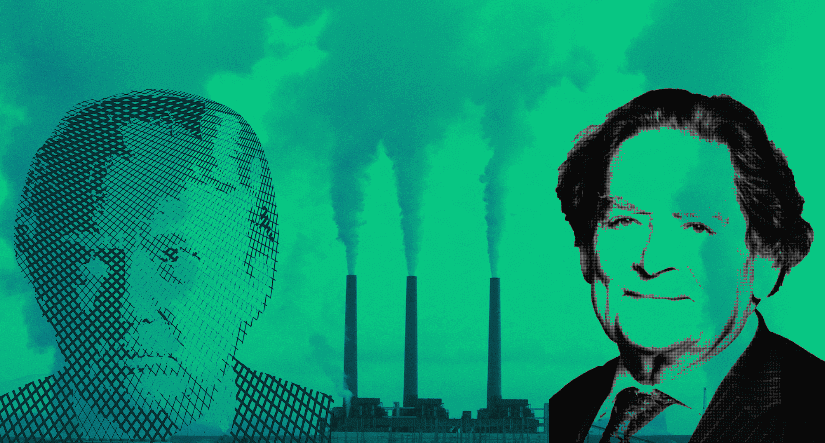Climate skepticism 101: is climate change real?

In a new series of articles, the Switch looks at the arguments of climate change deniers, those stubborn souls who refuse to acknowledge overwhelming scientific evidence and accept climate change as a fact. Is there anything to back them up or are they just tilting at wind turbines?
Who remains a climate change denier?
The 2010s have drawn to a close and scientists have now confirmed it as the hottest decade in the historical record.
The last year alone brought the highest temperatures ever officially measured in Europe and people around the world suffered amid unprecedented wildfires and heatwaves, while scientists reported vanishing glaciers, ice caps in continual retreat, and CO2 levels higher than any other point in the past three million years.
Yet, according to current US president Donald Trump, “global warming is an expensive hoax”.
Soon after taking office, Mr Trump turned his public position into policy and announced that he would withdraw the United States from the 2015 Paris Climate Agreement.
The Paris Agreement sets a target for countries to keep the increase in global average temperature to well below 2 °C by making the switch to renewable energy sources and transitioning to net-zero carbon emission economies.

The US, the largest carbon dioxide emitter in history, will be the sole nation in the world to withdraw from the treaty. Other big polluters including the EU, Russia, China and India have all ratified the agreement which has been signed by 196 countries.
Once it has fully withdrawn later in 2020, the US will join Syria and Nicaragua as the only countries which have rejected the plan.
However, Mr Trump’s disbelief in climate change is not shared by the majority of US citizens.
A 2019 poll by researchers at Yale University found that 69% of Americans agree that global warming is actually happening.
Another way of looking at this is that it means 31%, almost one third, of the US public does not accept that a climate emergency is in progress or that it poses an existential risk to our way of life.
In the UK, the numbers are somewhat different, but 12%, or one in eight UK citizens, still believe Trump’s hoax claim is correct according to a survey by King’s College London and Ipsos MORI.
Even if people admit there is an emergency in progress, there’s still the question of what is causing the climate to change.
The Yale study shows that about three in ten Americans, or 30%, don’t accept the science that shows it’s a consequence of human CO2 emissions, which is why we talk about "anthropogenic" climate change. Instead they blame it mostly or entirely on unspecified “natural changes in the environment.”
Meanwhile, a 2019 ComRes poll found that 15% of the UK public disagree that humans are the principal cause of the warming climate, with another 18% stating that they “don’t know” either way.
Different polls give slightly different numbers, but there is still a number of people who either reject the idea that we are in a climate emergency full stop, or who accept that the climate is changing but believe that humans bear little to no responsibility for the situation.
So, who’s right Mr Trump and the skeptics or the scientists? What are the main arguments of climate skeptics in 2020 and does the science support their claims?
Let’s start right at the beginning, shall we?
Climate change isn’t real!
A survey by Pew Research carried out in 2018 found that about six-in-ten Americans, or 59%, thought that climate change was having some or a great deal of an effect on their local community.
People mentioned things such as changes in the seasons along with increases in severe storms, droughts, floods and wildfires as evidence for their view.
A similar poll in the UK found 74% of people in Britain said they too were seeing the influence of the climate crisis, with about two-thirds describing it as a “direct threat” to ordinary people in the country.
That’s all well and good, but a true skeptic knows that personal feelings, anecdotes and experiences are not valid sources of data to draw broader conclusions from. Objectivity demands verifiable external evidence.
Why do scientists think the world is getting hotter?
We’ve all heard politicians, celebrities and scientists pontificating over and over again about global warming, climate change and rising temperatures. But is it true? And how do they know?
Well, the temperature rise they’re all complaining about is a calculated average which represents the increasing energy imbalance in the Earth’s climate system as a whole compared to the relatively stable energy balance human civilizations have enjoyed for the last 11,000 years.
Almost all of our heat comes from the Sun. It warms the Earth and some of that heat energy is absorbed by the oceans, land and atmosphere and some is reflected back into space. Of course, some can be used to cook your Sunday lunch as well.
Well-understood principles of physics and chemistry mean that more CO2 will prevent more and more of the heat we get from the Sun from escaping naturally back into space.
In fact, the climate change hypothesis was predicted 183 years ago by Joseph Fourier, a French mathematician and physicist who studied the thermal properties of the atmosphere.
Later, American scientist Eunice Newton Foote identified the heat-trapping danger posed by excess CO2 in 1856.
Climate science shows that there is now more CO2 being pumped out than the ecosystem has had to deal with than at any time in the last three million years.
A quick glance at the emissions outputs of modern industry, transportation and energy infrastructure should tell any objective observer that this is an obvious, if shocking, fact.
Is the Earth really getting hotter?
A scientific hypothesis allows scientists to make predictions. These predictions can then be checked through experiments and observations and lead to conclusions which help confirm or deny the initial hypothesis.
This is how science works, it’s how we started on the paths that led to the development of drugs to fight deadly diseases, nuclear weapons and wifi-connected smart toothbrushes.
So, what do scientists look at to test the climate change hypothesis?
Obviously climate researchers don’t sit around in a lab watching one thermometer labelled “Earth’s temperature”, they draw their data from a wide variety of sources.
Land surface temperatures as measured by thermometers in weather stations across the world are one such source.
Recording thermometer readings globally over decades might seem like a fairly simple and reliable way to check if the climate is changing, but it’s not as straightforward as you might think.
In fact, the locations of these weather stations is a favourite criticism of skeptics.
Many stations are situated in urban areas and so often record higher temperatures than elsewhere due to something called “the urban heat island effect”.
This is a phenomenon that means cities are typically hotter than the rural areas around them due to lack of plants, the heat-retaining behaviour of materials like concrete, metal and asphalt and the greater energy produced by millions of people living in a small area.
Skeptics say that as cities have grown in size over the last couple of centuries, the supposed rise in average global temperature could be a result of urban sprawl skewing the temperature readings.
So what do the climate geeks say about that?
Well, as it turns out, scientists are well aware of this effect, they have known about it since 1810.
They filter out the difference caused by the heat island effect and when comparing the trends of warming seen in weather stations located cities with the trends seen in rural areas the same rise in temperature is visible.
On top of that, 42% of temperature readings taken from cities are actually lower than rural ones as many urban weather stations are located in “cool islands” such as parks and the same warming trend is present in these cases too.
Ok, but the land surface temperature record is just one source of data in support of the climate change hypothesis, what else do the researchers have to back it up?
There are buoys, ships and weather balloons packed with scientific instruments operated by independent teams and institutions from countries all around the world.
These include not just thermometers, but also barometers for measuring atmospheric pressure, hygrometers for measuring humidity, pyranometers for measuring solar radiation, rain gauges, precipitation identification sensors and more.
Fleets of American, European, Russian, Indian and Chinese satellites monitor the Earth and its climate in a multitude of ways.
From the moisture content of the air and soil to ice levels and from ocean volume to vegetation coverage. Other satellites monitoring the sun and measuring distortions in the Earth’s gravity field are also used in climate science research.
What does all this fancy equipment show?
There is indeed also a warming trend visible in records of temperatures from the surface of the oceans, the air above them and in the atmosphere’s lower troposphere region.
There is also a trend of increasing heat within the oceans themselves as demonstrated in the rising sea level - hot water takes up more space than cold water, so the warmer the ocean, the higher the tides.
Then there’s the melting and retreat of glaciers worldwide, the decrease in snow in the northern hemisphere and the dramatic ongoing shrinkage of the arctic ice cap.
Biologists too are recording evidence of planetary climate change. It can be seen in the disruption to growing cycles of plants and other organisms and the change in what types of vegetation are growing where.
The bleaching and dying off of vast coral reefs provide visual proof of the oceans heating up.
As the coral reacts badly to the rising temperatures they lose the symbiotic organisms which give them their colour and which help them survive and reproduce. This bleaching also makes the coral more vulnerable to deadly infections.
What’s more, the reefs point to the damage caused by excess CO2 in the ecosystem.
The oceans absorb a lot of the extra CO2 we are pumping into the air and this absorption is turning the ocean water more acidic, making it even more difficult for the coral to grow. But we’ll look at CO2 more in the next article in this series.
Researchers studying animals have found that, as expected, many species are abandoning their traditional habitats and their normal life cycles are altering in response to the rising temperatures.
Climate change was even predicted to cause animals to shrink in size, a process which has now been observed happening in the wild.
Physics, chemistry, biology, botany and zoology are all providing evidence confirming the climate scientists’ hypothesis. What’s a global warming skeptic to do?
DIY climate skepticism for all
The motto of the UK's Royal Society, the oldest national scientific institution in the world, is "Nullius in verba", which basically means “take nobody's word for it.” The implication is that scientific conclusions must be based on evidence, not solely on the authority of the speaker.
To disprove the reality of climate change, all skeptics need to do is to show that each of these warming trends recorded in countries around the world by tens of thousands of scientists are errors or hoaxes.
Luckily, the data records from most, if not all, of the climate change monitoring systems mentioned earlier are available to the public for research and analysis.

The software the scientists use to process the raw data is also available for you to download, along with the source code so anyone can see how it works and verify that it’s doing what the scientists claim it’s doing.
And if you still don’t trust the scientists, many of the same measurements can be checked with some simple equipment from Amazon or Ebay, time and a bit of scientific rigour.
So, skeptics, what are you waiting for?
For everyone else, remember, one of the most significant ways you can help out in the climate emergency is to make the Switch to renewable energy. Click here to find out how.
by Damien Crossan
